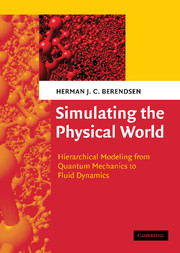Book contents
- Frontmatter
- Contents
- Preface
- Symbols, units and constants
- Part I A Modeling Hierarchy for Simulations
- 1 Introduction
- 2 Quantum mechanics: principles and relativistic effects
- 3 From quantum to classical mechanics: when and how
- 4 Quantum chemistry: solving the time-independent Schrödinger equation
- 5 Dynamics of mixed quantum/classical systems
- 6 Molecular dynamics
- 7 Free energy, entropy and potential of mean force
- 8 Stochastic dynamics: reducing degrees of freedom
- 9 Coarse graining from particles to fluid dynamics
- 10 Mesoscopic continuum dynamics
- 11 Dissipative particle dynamics
- Part II Physical and Theoretical Concepts
- References
- Index
1 - Introduction
Published online by Cambridge University Press: 05 June 2012
- Frontmatter
- Contents
- Preface
- Symbols, units and constants
- Part I A Modeling Hierarchy for Simulations
- 1 Introduction
- 2 Quantum mechanics: principles and relativistic effects
- 3 From quantum to classical mechanics: when and how
- 4 Quantum chemistry: solving the time-independent Schrödinger equation
- 5 Dynamics of mixed quantum/classical systems
- 6 Molecular dynamics
- 7 Free energy, entropy and potential of mean force
- 8 Stochastic dynamics: reducing degrees of freedom
- 9 Coarse graining from particles to fluid dynamics
- 10 Mesoscopic continuum dynamics
- 11 Dissipative particle dynamics
- Part II Physical and Theoretical Concepts
- References
- Index
Summary
What is this book about?
Simulation of real systems
Computer simulations of real systems require a model of that reality. A model consists of both a representation of the system and a set of rules that describe the behavior of the system. For dynamical descriptions one needs in addition a specification of the initial state of the system, and if the response to external influences is required, a specification of the external influences.
Both the model and the method of solution depend on the purpose of the simulation: they should be accurate and efficient. The model should be chosen accordingly. For example, an accurate quantum-mechanical description of the behavior of a many-particle system is not efficient for studying the flow of air around a moving wing; on the other hand, the Navier–Stokes equations – efficient for fluid motion – cannot give an accurate description of the chemical reaction in an explosion motor. Accurate means that the simulation will reliably (within a required accuracy) predict the real behavior of the real system, and efficient means “feasible with the available technical means.” This combination of requirements rules out a number of questions; whether a question is answerable by simulation depends on:
the state of theoretical development (models and methods of solution);
the computational capabilities;
the possibilities to implement the methods of solution in algorithms;
the possibilities to validate the model.
Validation means the assessment of the accuracy of the model (compared to physical reality) by critical experimental tests.
- Type
- Chapter
- Information
- Simulating the Physical WorldHierarchical Modeling from Quantum Mechanics to Fluid Dynamics, pp. 3 - 18Publisher: Cambridge University PressPrint publication year: 2007



